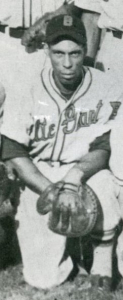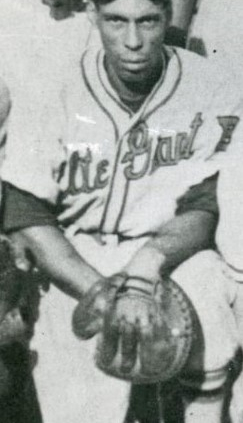Leon Childress
 Leon “Boogie Wolf” Childress is one of many obscure “ghost players” of the Negro Leagues, a player skilled enough to make it onto the rosters and even into group photographs of some very good teams, but never earning regular playing time or appearing in any statistical record.
Leon “Boogie Wolf” Childress is one of many obscure “ghost players” of the Negro Leagues, a player skilled enough to make it onto the rosters and even into group photographs of some very good teams, but never earning regular playing time or appearing in any statistical record.
Leon was born on June 23, 1910, in Nashville, Tennessee, where he would spend most of his life. Nettie Johnson is listed as his mother, but 1930 census data notes that he was adopted and the only child in the household. His education ended after the sixth grade, and he took up work as a “boat-black” in a shoe shop with his father, Ike.1
In his early years, Childress was more accomplished on the football field than on the baseball diamond. In 1931 he joined the “other” Nashville Elite Giants, a semipro football team. The Elite Giants football team played their home games at Wilson Park and were an extension of Tom Wilson’s baseball team. In 1932 Wilson and his business partners Dr. R.B. Jackson and Vernon Green created the Negro Southern Football League. That December, Jackson declared that the Elite Giants were “mythical” national champions due to their record. Leon Childress was listed as an “All-Southern” End on the roster.2 One of Leon’s teammates on the Elite Giants was running back Wild Bill Wright, a young outfielder on the baseball team of the same name and at the beginning of a career that spanned two decades.3
Where he began his baseball career is a bit foggier. “Childress” was a fairly common surname, with an infielder-pitcher named Childress appearing on the roster of the Little Rock Stars in 1933,4 a Guthrie Childress pitching for the Claybrook, Arkansas Tigers at the same time,5 and a set of Childress brothers playing in Texas for the San Angelo Black Sheepherders.6
In 1935 Leon Childress moved north and made the roster of the Cincinnati Tigers, a team formed by a local hero and Olympic gold medalist in track and field, DeHart Hubbard.7 Hubbard formed the Tigers in 1934 with a core of young players from the “Class A” league in the city and augmented the team with solid backups like Childress and his football teammate Charles “Dusty” Decker. The Tigers played in the Negro Southern League and the integrated Indiana-Ohio League for their first few years of existence before later joining the Negro American League.
On a barnstorming trip out west on June 28, 1936, Childress stepped in for starting catcher Josh Johnson in the second game of a doubleheader against the famed integrated Bismarck Churchills, going hitless but scoring a run in a 5-4 victory.8 On July 12 and 13, Childress was loaned to the Saskatoon Gems for a series against the Tigers along with Porter Moss, Ewing Russell, Jerry Gibson, and Sonny Harris. Childress had only one hit in eight at-bats for the Gems as the Tigers swept all three games.9 Aside from photographs, the accounts of these appearances are the only evidence of his time in Cincinnati. When the Tigers joined the Negro American League in 1937, Childress was no longer on the club and disappeared from high-level baseball again.
In 1939 Childress appears to have been captured by John Mosley in two separate photos of the Philadelphia Stars but did not appear in any documented games and was possibly released before the regular season began.10
By the summer, Childress was in uniform with the Baltimore Elite Giants, backing up Roy Campanella and appearing in a team photo at Oriole Park next to recent acquisition Red Moore.11 Childress is not credited with any league appearances but “the recruit from Nashville” remained on the team for “emergency duty behind the plate” through the end of the season.12 It may be reasonable to speculate that while his playing time was limited, Childress’s value to the team was indispensable in other duties to include driving the bus, managing equipment, and catching in the bullpen. After the Elites won the Jacob Ruppert Cup, the team posed for a photograph at Yankee Stadium with the trophy. Childress is clearly visible in the photo between Emery “Ace” Adams and Wild Bill Wright.13 One of his only documented appearances for the Elites occurred a few days earlier on September 20, when he went 0-for-3 at the plate and committed an error and two passed balls in a 3-1 loss to the Brooklyn Bushwicks.14
Out of a big-league job in 1940, Childress returned home to Nashville and fell back to earth. In September he was arrested and charged with loitering, vagrancy, and a lottery violation.15 It should be noted, however, that in the Jim Crow South, vagrancy was a trumped-up charge aimed at punishing Black people for being unemployed or homeless. This practice stretched back to the post-Reconstruction days, with laws in many places coming off the books only in recent years.16
That fall, Childress registered for the military draft, a year before the United States’ entry into World War II. His residence is listed at Eighth Street, the same address listed in his arrest report. His occupation was described as “unemployed.”
Childress’s activities in 1941 are unknown, but in 1942 he reappeared in the spotlight. On New Year’s Day, he returned to the gridiron and played end and quarterback for the Nashville Pros against the Southern All-Stars in the second annual “Steel Bowl” game in Birmingham, Alabama. The Pros were an independent club that came into the matchup advertised as winners of 29 of their last 30 games, while their opponent was made up of college stars from several Black colleges in the region.17 Childress was part of a “desperate passing attack that netted two touchdowns” in the last minutes of a 26-13 loss.18
In the spring of 1942, Childress returned to the baseball diamond. The Louisville and Nashville railroad company sponsored an independent team called the Nashville L&N Stars, often shortened to just “Nashville Stars” and sometimes referred to as the “Railroaders” in the press. Childress joined the club as their starting catcher and manager. In May 1942 the Nashville Tennessean reported that Childress and teammate Jim Willis were leaving for the Army,19 but he was still managing and playing on August 12 when the Stars traveled to Cincinnati for a doubleheader against the Clowns.20
In 1943 Childress took over the managerial reins of the Nashville Black Vols, a separate club from the Stars.21 Childress was no longer playing regularly but was described by the Atlanta Daily World as a “good hitter and fence buster.”22 In an uncommon stance of a Negro League team operating a minor-league affiliate, the Black Vols were owned by Elite Giants magnate Tom Wilson, who regularly shuttled players between the two clubs. In February 1944, his draft number was called, but he was designated as 4F, or physically unfit for service.23
Childress was still on the roster for the Black Vols in 1945 as they joined the resurrected Negro Southern League but was replaced as skipper by veteran Bill Perkins. The Black Vols finished behind the Atlanta Black Crackers in both halves of the season and went through at least three other managers – Bill Perkins, Granville Lyons, and Judge “Dusty” Owens. Childress split catching duties with Perkins throughout the season and appeared on the mound at least once. Box scores and complete statistics have yet to be found for any of the NSL’s games in 1945.24 In 1946 Childress was no longer with Nashville (now rebranded as the Cubs) and presumably out of professional baseball for good.
On May 10, 1948, he married Frances Mattie Mayberry of Williamson, Tennessee. Childress took a job as a mail handler for the post office, where he worked for at least a decade, according to census records. He remained active in the Nashville baseball scene into the 1960s on the coaching staff of the amateur Elite Giants in the Capital City League. In 1962 he was named to the staff of the league’s all-star team. 25
Just six years later, on September 21, 1968, Childress was reportedly at a bus stop in Nashville when he was approached by police officers and violently arrested for vagrancy. After he questioned why he was being arrested, he was beaten at the police station and denied medical care, resulting in permanent hearing loss. Childress filed a $50,000 lawsuit against Nashville police officer William B. McCullough, who was later fired and charged for a separate incident in which he allegedly beat a suspect in an alleyway.26 The result of the suit was never published.
On July 30, 1976, at 66 years old, Leon Childress died in an unnamed Nashville hospital of an undisclosed illness. He was survived by his wife, Frances; six children; and nine grandchildren.27 Frances died in 2002 at 80 years old. Perhaps Childress’s lineage is best defined on the football field: His son Jerome played football for Tennessee State University, and his grandsons Ahmad and Gary played for Alabama and Clemson respectively.28 Another grandson, O.J. Childress, played linebacker in the NFL for the Giants.29 Boogie Wolf Childress may not have been a household name outside of his hometown, but his contributions and legacy as an athlete, manager, husband, and father reverberate through generations.
Sources
In addition to the sources cited in the Notes, the author used Ancestry.com to gather biographical data including birth, death, marriage, and military service information.
Notes
1 While listed as “boat-black” in census data, this may have been a typographical error. His actual job title was likely a “bootblack,” a profession frequently held by older male children at the time.
2 “Nashville Elite Giants Claim National Pro Football Title,” Nashville Banner, December 24, 1932: 15.
3 “Elite Giants to Engage Soldiers,” Nashville Banner, December 4, 1932: 14.
4 William Plott, The Negro Southern League: A Baseball History, 1920-1951 (Jefferson, North Carolina: McFarland & Company Inc., 2015), 222.
5 Claybrook’s Tigers Show Form in Win,” Chicago Defender, August 5, 1933: 9.
6 “Black Hubbers Meet 2 Teams at Local Park,” Lubbock (Texas) Morning Avalanche, June 19, 1937: 2.
7 Chi “ldress is identified in team photographs with the Tigers as both “Wolf” and “Wolf Childers” – a common shortening and misspelling that appeared to follow him throughout his career. Phil Dixon and Patrick Hannigan, The Negro Baseball Leagues, 1867-1955: A Photographic History (Mattituck, New York: Amereon House, 1992), 164.
8 “Bismarck, Cincinnati Tigers Split Week-End Series,” Bismarck (North Dakota) Tribune, June 29, 1936: 8.
9 “Gems Drop Both Games,” Saskatoon (Saskatchewan) Star-Phoenix, July 16, 1936: 10.
10 In Mosley’s photographs of the Philadelphia Stars, the club is wearing the Baseball Centennial patch that was worn across all of baseball for a single season, dating the photo to 1939. John Mosley, “Philadelphia Stars Player,” Temple University Digital Collections, https://digital.library.temple.edu/digital/collection/p15037coll17/id/213/rec/32, accessed December 13, 2023.
11 Childress is simply identified as “Wolf C” in handwriting on the photograph. Bill Stetka, “Celebrating Negro Leagues Day in Maryland,” MLB.com, https://www.mlb.com/news/featured/celebrating-negro-leagues-day-in-maryland, accessed December 13, 2023.
12 “Elites to Play Grays for Championship,” Baltimore Afro-American, September 16, 1939: 23.
13 In this photograph, Childress is simply identified by his nickname of “Boogie Wolf.” Bob Luke, The Baltimore Elite Giants: Sport and Society in the Age of Negro League Baseball (Baltimore: Johns Hopkins University Press, 2009), 51.
14 “Bushwicks Nip Elite Giants in Arclight Finale,” Brooklyn Daily Eagle, September 21, 1939: 21.
15 “Lottery Violation,” Nashville Tennessean, September 15, 1940: 10.
16 Charles Gallagher and Cameron Lippard, Race and Racism in the United States: An Encyclopedia of the American Mosaic (Santa Barbara, California: Greenwood, 2014), 145.
17 “Football,” Birmingham News, December 30, 1941: 17.
18 Childress was identified by “Wolf Childers” in some accounts of this game. “Steel Bowl Result,” Chicago Defender, January 10, 1942: 22.
19 “Castleman May Forgo Pro Career,” Nashville Tennessean May 17, 1942: 39.
20 “Clowns Card Double Bill,” Cincinnati Post, August 12, 1942: 12.
21 The Black Vols were renamed the Cubs in 1946 and had a rare meeting with the Stars in August of 1946. Childress was on neither club at the time. “Nashville Cubs, Stars Tangle in Twin Bill,” Nashville Tennessean, August 30, 1946: 36.
22 J.C. Chunn, “Nashville Black Vols and Atlanta Black Crackers Meet Tonight at Ponce De Leon,” Atlanta Daily World, June 24, 1943: 5.
23 “Board 9 Lists Classifications,” Nashville Banner, February 17, 1944: 2.
24 Plott, The Negro Southern League, 230.
25 “Capital Stars Feature Searcy vs. Tri-State,” Nashville Tennessean, July 20, 1962: 17.
26 “Nashville Man Seeks 50,000 in Damage Suit,” Elizabethton (Tennessee) Star, September 23, 1969: 1.
27 “Childress, Leon (Boogie Wolf),” Nashville Tennessean, August 1, 1976: 70.
28 Chip Cirillo, “All Everything,” Nashville Tennessean, August 14, 1999: 27.
29 “O.J. Childress Stats, Height, Weight, Position, Draft, College,” Pro Football Reference, https://www.pro-football-reference.com/players/C/ChilO.20.htm, accessed December 16, 2023.
Full Name
Leon Childress
Born
June 23, 1910 at Nashville, TN (USA)
Died
July 30, 1976 at Nashville, TN (USA)
If you can help us improve this player’s biography, contact us.


